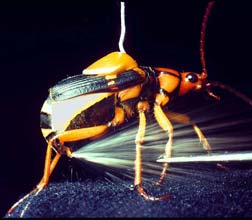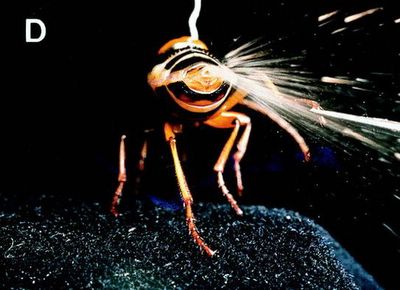Chrysomeline (Leaf) beetles, for example, have chemical defense glands. Originally, they synthesized the chemicals themselves. During the course of their evolution, however, the became dependent on plant hosts to acquire the chemicals they use for defense (in other words, they incorporate the host plants toxins into their own defense system). One group within the Chrysomelines (the interuptus group)however, has managed to adapt to a wide variety of plant hosts and uses a wide variety of chemical defenses. One of the more interesting things about this is that in order to go from self synthesized to use of host derived chemicals only requires the change of one or two enzymes. To go from the use of host derived metabolites to use of many hosts also requires the change of one or two enzymes.
Fireflies illustrate another, creepy, way insects can acquire chemical defenses. Female fireflies of the genus Photuris imitate females of the genus Photinus. Once they attract a male of the genus Photinus they eat him! Photinus species have a chemical called lucibufagin (similar to a chemical found in the chinese toad) which are extremely noxius to the insects that prey on fireflies (mainly jumping spiders). So female Photuris acquire the chemical by ingesting male Photinus. Then when attacked they engage in what is called reflexive bleeding and the chemical in their blood drives the predator away. They also incorporate the chemical into eggs when they lay them so their offspring is protected.
Peruvian fire sticks (related to the walking sticks) also use chemical defenses. They are rather unique in that a lot of species, when molting, shed their defensive glands. Fire sticks shed the cuticle lining, but do not shed the gland itself. Consequently, they do not have to wait as long after molting to use their chemical defense. The glands are located near their neck. The chenical is sometimes ejected as a spray but more often is oozed out as a froth and spreads down the thorax. The chemical is related to quinoline and other species of walking stick do not have this type of chemical. In that sense Peruvian firesticks are unique.
Opilionid beetles are similar to the Peruvian fire sticks in the way the use their chemical defenses, but not identical. A bubble of enteric fluid is dribbled out their mouth and onto a track which runs by their glands, where quinonoid paste is injected into the enteric fluid. This bubble then moves down a groove on the beetles carapace. The beetles use it back legs to scoop some of this mixture of and tries to smear it on it's attacker.
Which brings us to the Bombardier beetle. Bombardier beetles compose two branches in family Carabidae (brachinoid and paussoid). The Paussoid branch is believed to be older and more primitive (in evolutionary terms). One of these (Metrius contractus) is believed to be close to the ancestral condition for Bombardier beetles. It has two gland openings near the abdominal tip. The glands themselves are cuticle lined and have two chambers (as in all Bombardier beetles). When attacked the froth is emitted and either runs down a track (if attacked in the front)or builds up near the glands (if attacked from the rear). M. contractus is unusual in that the froth develops into a mist, whereas in brachinoid species it is sprayed in any direction. M. contractus is also unique in that the froth is only 50 degrees centigrade rather than one hundred degrees centigrade as in brachinoid species.
Which brings us to the Bombardier species proper. The species pictured below is Stenaptinus insignis.
A single bombardier beetle can discharge upward of 20 times
before depleting its glands (6). The discharges are accompa-nied
by audible detonations, and they have been shown to be
potently deterrent to a number of predators, including ants (6,
12–15).
The spray of bombardier beetles is ejected at 100°C (13).
This is because the quinones are generated explosively at the
moment of ejection by the mixture of two sets of chemicals
ordinarily stored separately in the glands. Each gland consists
of two confluent compartments. The larger of these (storage
chamber or reservoir) contains hydroquinones and hydrogen
peroxide while the smaller one (reaction chamber) contains
special enzymes (catalases and peroxidases). To activate the
spray, the beetle mixes the contents of the two compartments,
causing oxygen to be liberated from hydrogen peroxide and the
hydroquinones to be oxidized by the freed oxygen. The oxygen
also acts as the propellant, causing the mixture to ‘‘pop’’ out
(16–18). The heat that accompanies the formation of the spray
is perceptible (13) and contributes to the defensive effective-ness
of the secretion (14, 15). An early explorer, reporting on
large bombardier beetles from the neotropics, commented that
when these ‘‘play off their artillery’’ they are so hot to the touch
‘‘that only few (can) be captured with the naked hand’’ (19).
Although it was known that bombardier beetles can aim their
spray by revolving the abdominal tip (6), the degree of
precision with which they target their ejections had escaped
notice. (from THOMAS EISNER AND DANIEL J. ANESHANSLEY, (1999) Spray aiming in the bombardier beetle: Photographic evidence. Proc. Natl. Acad. Sci. USA
Vol. 96, pp. 9705–9709, August 1999)
Bombardier 1


This first picture shows a bettle directing the spray to the front. Note the glob of stuff on it's back. They attached a wire to the beetle by embedding it in wax. They then used the wire to handle the beetle.


This second picture shows a beetle directing the spray backwards.


The third shows the beetle directing the spray to the right rear - note the forceps, they had to pinch it's leg to set it off.
In addition to the insects mentioned above, a wide variety of other insect use some form of chemical defense including: millipedes, cockroaches, ants, termites earwigs and grasshoppers to name a few (but I'm still in shock about the male-eating fireflies. I am used to that kind of thing in, say, black widow spiders, but not in lightening bugs!).
So, we have a wide variety of different chemicals, a large number of different ways of getting the chemicals and delivering them (we could have given details on Opilionid beetles and millipedes as well). In some cases, the differences are caused by differences in a few enzymes. I have done much research into the origins and evolution of these systems, but from what I have read so far Bombardier beetles don't represent that much of a challenge to evolutionary theory. Rather, they seem to be a specialization of several traits already present in nature in one form or another - benzoquinones, for example, are used by a wide variety of insects.
I will probably write some more about this in the future. I just need to do some more research into a really fascinating area of biology (it's referred to as chemical ecology in the literature I've read).








